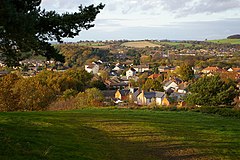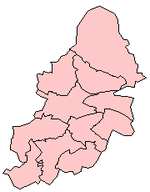History
The first evidence of people settling in the area dates back to the Stone Age, when a Neolithic hunter lost a flint arrow head on Rednal Hill. The arrow head is leaf-shaped and made of flint and is certainly over 4000 years old. Additionally a 3000-year-old flint javelin point was found lying on the surface by an observant Mr W. H. Laurie when the Lickey's road was being widened in 1925. A flint-scraping tool was found in the area near the Earl of Plymouth monument. The artefacts are on display at Birmingham Museum and Art Gallery. [1]
The Romans constructed a road over the Lickeys very near to the present Rose Hill gap before it swung north through Rednal and followed the route of the presentgday Bristol Road South. The road would have been used to transport salt and other goods between the Roman encampments at Worcester and Metchley, near where Birmingham's Queen Elizabeth Hospital now stands. It would have also been used as a military marching route by Roman soldiers. In 1963, a Roman coin was found near Rednal Hill School by a Janet and Stephen Harris. The coin was a dupondius struck during the reign of Emperor Antoninus Pius, who ruled Rome and Britain from 138 to 161. The tiny coin was struck from brass and would have been worth about the price of a loaf of bread. [2]
In Norman times, Rednal and the Lickeys formed part of the royal manor of Bromsgrove and were set aside as a royal hunting forest. As well as stocking the area with deer, the Normans deliberately introduced rabbits to the area that were kept in large enclosures, or 'warrens', hence the road and place names. The word 'forest' means 'place of deer' and did not necessarily mean that the area was totally covered with trees.
Rednal was known by the Anglo-Saxon name, Wreodan Healh, meaning 'thicket nook'. Together with Kings Norton and other sub-manors, Rednal is listed as Weredeshale in the Domesday Book, a berewick of Bromsgrove belonging to the king. A 20th-century housing estate has reinstated the name of Wreodanhale into modern usage. The name was recorded as early as 849 and is mentioned in the Cofton Lease, one of the few surviving Anglo-Saxon charter documents in the West Midlands. The charter designated land around Cofton Hackett and Rednal to be leased by Bishop Ealhun of Worcester to King Berhtwulf in AD 849.
Running along the west side of Lickey Road, between Leach Green Lane and past Edgewood Road, is a medieval hedge estimated to be over 700 years old. [3] The manor was sold by crown charter in 1682 to the Earl of Plymouth, who lived at nearby Tardebigge, and his descendants would own the lands at Rednal, Longbridge, Cofton Hackett and the Lickey Hills for the next 250 years.
In 1888, I the Birmingham Society for the Preservation of Open Spaces purchased Rednal Hill and handed it to the city in trust. It also arranged for Pinfield Wood and Bilberry Hill to be leased on a peppercorn (nominal) rent. Birmingham City Council finally purchased Cofton Hill, Lickey Warren and Pinfield Wood outright in 1920. With the eventual purchase of the Rose Hill Estate from the Cadbury family in 1923, free public access was finally restored to the entire hills.
An early provision for the small rural community was the Rednal Public Library built in 1909 by King's Norton & Northfield Urban District Council on Leach Green Lane. The site was donated by Edward Cadbury and George Cadbury Jnr, and the building costs met by philanthropist, Andrew Carnegie.
In 1917, the Austin Aero Company built an airfield right next to Rednal, just on the other side the Lickey Road and north east of Cofton Hackett Park. The airfield was used for flying aeroplanes out of the Cofton Hackett aircraft factory. Between 1939 and 1945, the factory produced mainly Hawker Hurricane fighters, Short Stirling four-engined bombers that were flown out over Rednal.
In 1924, the Birmingham tram system was extended along the central reservation of the Bristol Road South to the new Rednal Terminus, with a branch to Rubery. The new line drew thousands of visitors from the city and all over the Black Country to Rednal and the Lickeys at weekends and on bank holidays. There are records of crowds as far back as the Rose and Crown up Rose Hill on busy Sundays, as families queued for the trams to take them home. The trams were removed when the trams were replaced by buses in 1953, but the terminus turning circle and its extensive waiting shelter remained in situ until well into the 1960s, and it is believed that they continued to be used by the buses on bank holidays. The original tram station offices are now used as a Chinese restaurant. A small development of retirement homes and a carpark were built on the site of the terminus, but several short lengths of tramlines are still visible on front gardens and pathways.
In preparation for the Second World War, deep shelter tunnels were dug alongside Rednal in 1936 to accommodate up to 15,000 people. The main tunnels were under the South Works and were also driven under the Flying Ground through the sandstone towards the Cofton Hackett aircraft factory, a task undertaken by an army of mining engineers. The tunnels were large enough to admit 3-ton lorries. The tunnels under the South Works were intended to be used mainly ands air raids, but although some machine tools were installed, allowing work to continue. The tunnels under the airfield and the Cofton factory were designed for use during the assembling aero engines and even aircraft but they also contained a St John's Ambulance Station, staffed by first-aid qualified factory workers. Used in later years for moving partially-completed cars around the site, the tunnels still exist under the demolished factories, and many photographs taken by 'Subterranean Britain' explorers have surfaced on the Internet.
Major housing development in Rednal did not begin until after the war, with the construction of the Rednal Hall council estate, where over 600 houses added.
Economy
With the demise of the Longbridge Motor Factory there is little in the way of major employment in the immediate area. Rednal barely existed prior to the factory, coming into being in its current form as a result of four events. Firstly the opening of the Austin motor works at Longbridge in 1905, secondly the extension of the area of the City of Birmingham to the northern boundary of Cofton Hackett in 1911. Thirdly the break-up of the Earl of Plymouth's estate by auction in 1919, and lastly the extension of the Birmingham tramlines to the Rednal terminus in 1924.
These events had carried Rednal very rapidly from the rural age of the horse and cart to that of the motor car and bus, and from a community depending chiefly on farming to a delightful dormitory for people nearly all of whom now travel into central Birmingham to work. Most of the shops are in an area on the southern edge of the village that was administratively transferred from Kings Norton only in 1911.
The previous MG Rover site was purchased by St Modwen and discussions since 2006 have taken place between residents, county, district and parish councils, West Midlands Development Agency and central government officials on suitable development plans for the site. The 2008 downturn in the worldwide economy has slowed the progression of any new development. Situated where the Bristol Road meets Longbridge Lane, the Longbridge Technology Park was completed in late 2007; in 2008 one of the two buildings is occupied but the other is still vacant.
A major development aimed to improve the Longbridge ward was the Great Park development in Rubery [4] by Corporate Land Developments Ltd. The 200-acre (80-hectare) site just off junction 4 on the M5 Motorway has been developed into a community with offices, houses, industrial units, Empire Cinemas, Hollywood Bowl, Premier Inn, Brewers Fayre, Morrisons, Gala Bingo, Greens Fitness and an area of public open space.
Rednal is also now the home of the NASUWT, the UK's largest teachers' union. Their premises, which includes training rooms and accommodation, is at Hillscourt, close to the Lickey Hills footpaths.




